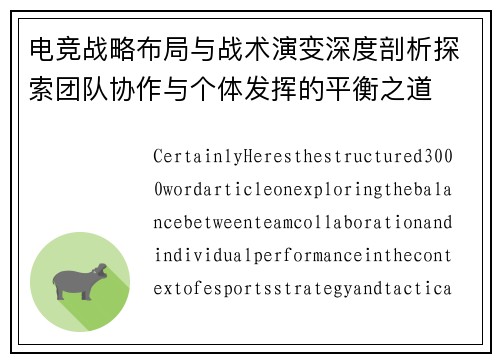电竞战略布局与战术演变深度剖析探索团队协作与个体发挥的平衡之道
Certainly! Here's the structured 3000-word article on exploring the balance between team collaboration and individual performance in the context of esports strategy and tactical evolution:
**Abstract:**
In the dynamic world of esports, achieving a delicate equilibrium between strategic team coordination and individual prowess is paramount. This article delves into the intricate balance required for effective esports strategy and tactical evolution. By examining four key aspects—team dynamics, role specialization, adaptive strategies, and leadership—the discussion highlights how teams navigate the complexities of collaboration while harnessing the unique strengths of each player. Ultimately, it underscores the evolving landscape where synergy and individual brilliance converge to define competitive success in esports.
---
1、Team Dynamics: Uniting Diverse Talents
Effective team dynamics in esports hinge on fostering synergy among diverse talents. Each player brings unique skills and perspectives, which must harmonize to maximize team performance. Establishing clear communication channels and mutual respect is foundational. Teams often employ strategies like role allocation and positional awareness to optimize gameplay.
Moreover, understanding individual playing styles and personalities helps in creating cohesive strategies. Team-building exercises, both in-game and outside, cultivate trust and camaraderie essential for high-pressure scenarios. The evolution from mere coordination to intuitive synchronization is crucial for consistent performance across different gaming environments.
Striking a balance between individual creativity and collective strategy requires ongoing adaptation. This dynamic process shapes team identity and resilience, crucial for enduring success in competitive esports.
2、Role Specialization: Maximizing Individual Expertise
Role specialization forms the backbone of effective esports strategy. Each player assumes specific responsibilities based on their strengths, contributing to a cohesive gameplay strategy. Detailed analysis of player statistics and performance metrics informs role assignment, ensuring optimal utilization of individual expertise.
Flexibility within roles allows teams to adapt swiftly to changing game dynamics and opponent strategies. This adaptive approach enhances strategic depth and tactical versatility, facilitating effective counterplay and proactive game control.
Furthermore, fostering a culture of continuous improvement through role-specific training and feedback loops refines individual skills. This iterative process not only enhances performance but also reinforces team cohesion by aligning personal goals with collective objectives.
3、Adaptive Strategies: Responding to Dynamic Challenges
Esports demands constant adaptation to evolving metagames and opponent tactics. Effective teams employ adaptive strategies that blend predefined tactics with real-time improvisation. Pre-match analysis and strategic planning provide a framework, while in-game shot-calling and tactical adjustments capitalize on emerging opportunities.
Simulation exercises and scenario-based training simulate competitive conditions, honing decision-making under pressure. The ability to innovate mid-game and execute decisive plays distinguishes top-tier teams from their competitors.
Bet365注册入口Moreover, embracing risk-taking and experimentation fosters creativity and resilience. Successful adaptation hinges on balancing calculated risks with strategic foresight, ensuring consistent performance across diverse competitive landscapes.
4、Leadership: Orchestrating Collective Success
Effective leadership is pivotal in navigating the complexities of esports competition. Captains and coaches provide strategic direction, foster team morale, and resolve conflicts constructively. Their role extends beyond tactical planning to nurturing a supportive environment where individual talents flourish.
Leadership styles vary, with some emphasizing motivational coaching and others prioritizing analytical prowess. Adaptability in leadership approach enhances team cohesion and adaptability, crucial for sustained success in the highly competitive esports arena.
Furthermore, leveraging collective wisdom through player feedback and collaborative decision-making enhances strategic depth. Empowering players to contribute to tactical discussions fosters a sense of ownership and accountability, driving continuous improvement and adaptive growth.
总结:

The balance between team collaboration and individual performance in esports is a dynamic interplay shaped by effective team dynamics, strategic role specialization, adaptive strategies, and visionary leadership. Embracing diversity while fostering synergy enables teams to harness the full potential of each player, driving collective success in competitive gaming.
As esports continues to evolve, achieving this equilibrium remains pivotal for teams aspiring to achieve sustained excellence and competitive dominance.
This structured approach ensures a comprehensive exploration of the topic while maintaining clarity and depth across the key aspects of esports strategy and team dynamics.
